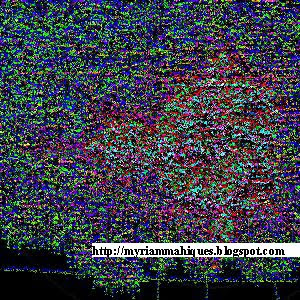This is a study of a Roman field with crops. The picture has been through filters and a deterministic Fractal's texture has been applied.
This one is a variation of the first one. Here, we are analyzing possible lacunarities.
This fractal has been generated with Cellular Automata. Notice there is a silohuette of a Mandelbrot's fractal, dilluted in the image. The intention was to study urban density with rough edges.
This fractal was originated on the Sierpinski carpet. We have an urban grid with some local centers.
This is an analogic deterministic fractal for an African settlement. The round shapes are a simulation of the round concentration of huts.
In Urban Morphology analysis sometimes I use deterministic fractals to compare the fractal tendency of cities. The first approach is to measure the fractal Dimension D of the selected urban shape and then the analogue Fractal's D. We have to take into account that some cities are not real fractals, they have a tendency to fractality. And the most difficult property to find is Autosimilarity. Anyway, the generation of fractals is an excellent tool to trigger urban design ideas. The same applies to facades.
I'm not taking advantage of the beautiful colors palette that softwares incorporate, because in all examples I'm focused on the fractal Dimension. These fractals were not intended to be artistic.
This one is an abstract of citie's grey facades, when we look at the distance and see all towers facades superimposed. And suddenly, from a tiny opening, the sun spreads in the urban composition.






No comments:
Post a Comment